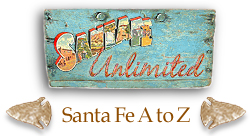|
|||
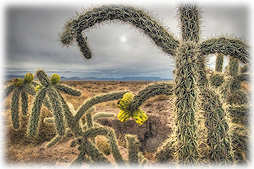 Cactus (Cacti) Cactus (Cacti)Definition: “A succulent plant with a thick, fleshy stem that typically bears spines, lacks leaves, and has brilliantly colored flowers. Cacti are native to arid regions of the New World and are cultivated elsewhere, especially as houseplants.” Cacti have a thick, hard-walled, succulent stem. When it rains, water is stored in the stem. The stems are photosynthetic, green and fleshy. The inside of the stem is either spongy or hollow (depending on the cactus). A thick, waxy coating keeps the water inside the cactus from evaporating. All cacti are succulents, but not all succulents are cacti. What separates a cactus from a succulent is the organs that produce the spines, and some other characteristics specific to fruit formation. Many of the smaller cactus that live in a desert environment are situated under bushes or in behind rocks and do not receive constant, intense sunlight. The native habitat of many other cacti is often at a higher altitude (where the light is strong, but the temperatures are far cooler than on the desert floor), or in tropical jungle-like environments. Many cactus dwell at higher altitudes and underneath pine trees, where they receive very little direct sun. The two types of cacti that are the most common in Nothern New Mexico are Prickly Pear and Cholla. Opuntias (both Prickly Pear and Cholla) are usually fast-growing, take little care, and many are very hardy. These beautiful cacti are famous for their distinct character and are standouts as specimens. Some Opuntias are miniatures that span only inches, and are essentially ground covers, while others are arborescent tree forms ranging up to 20 feet in height. Prickly Pear and Cholla cacti are found in all of the deserts of the American Southwest, with different species having adapted to different locales and elevation ranges. Most require coarse, well-drained soil in dry, rocky flats or slopes. But some prefer mountain pinon-juniper forests, while others require steep, rocky slopes in mountain foothills. (~Jean) NOTE: See our special feature on Cactus (Cacti) in Northern New Mexico Plants & Wildlife Camel Rock Camel Rock is an extraordinary rock formation on the Tesuque Pueblo, approximately 12 miles north of Santa Fe, New Mexico, on US 84/285. It is located directly across from the Pueblo’s Camel Rock Casino. Beloved by locals and visitors alike, the landmark is an example of nature at its most creative. (~Jean) See more about Camel Rock in Movie Locations of the Great Southwest 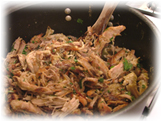 Carnitas CarnitasCarnitas, which literally translated means “little meats,” is a type of braised or roasted (often after first being simmered) pork in Mexican cuisine. It is also called “pulled pork.” Pork carnitas is traditionally made using the heavily marbled, rich “pork butt” or “picnic ham” cuts of pork. These are acutally the upper and lower sections of the front shoulder of the hog. The 6-to-16 lb. sections are usually cut down to a workable size and seasoned heavily before slow roasting, which can take up to 12 hours. After the roasting, the collagen in the meat has broken down sufficiently to allow it to be pulled apart by hand or fork, or easily chopped with a cleaver. Prior to serving, the pork is placed in fairly shallow pans to maximize surface area, then roasted at high heat for a few minutes to produce the delectible texture of succulent softness and caramelized crispness. Carnitas are served as a dish by itself, or as an ingredient in tamales, tacos, and burritos. (~Jean) 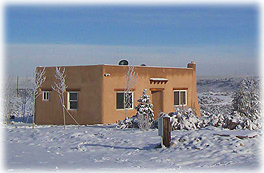 Casa CasaThe Spanish word for “house.” (~Jean) Casita The Spanish word for “little house.” Casitas are usually small, adobe style dwellings with only two or three rooms, although the term is also used for any small house or guest house in the Southwest. (~Jean) Catfish Definition: “A freshwater fish with whisker-like barbels around the mouth, typically bottom-dwelling.” Catfish is a common name applied to members of the freshwater fish families constituting the suborder Nematognathi. The catfish is related to the “carp,” “sucker” and “minnow,” and has a complex set of bones forming a sensitive hearing apparatus. Catfish are named for the "whiskers" around their mouths, which give them a cat-like appearance, also due to their flat, wide heads. They have scaleless skins. Catfish are omnivorous feeders and are valuable scavengers. Many small species are popular aquarium fishes, while many large species are used for food. 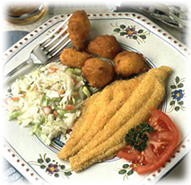 Of the 30 American catfish species, the largest and most important is the blue (or Mississippi) catfish, an excellent food fish weighing up to 150 pounds. Best known is the smaller channel catfish, which reaches 20 pounds and has a deeply forked tail and slender body. The stonecat is about 10 inches long and is found in clear water under logs and stones. The bullheads are catfish of muddy ponds and streams, feeding on bottom plants and animals. Bullheads have square or slightly rounded tails and may reach a foot in length and weigh up to two pounds. The black, yellow, and brown bullhead species are common in the waters of the Central and Eastern United States. Of the 30 American catfish species, the largest and most important is the blue (or Mississippi) catfish, an excellent food fish weighing up to 150 pounds. Best known is the smaller channel catfish, which reaches 20 pounds and has a deeply forked tail and slender body. The stonecat is about 10 inches long and is found in clear water under logs and stones. The bullheads are catfish of muddy ponds and streams, feeding on bottom plants and animals. Bullheads have square or slightly rounded tails and may reach a foot in length and weigh up to two pounds. The black, yellow, and brown bullhead species are common in the waters of the Central and Eastern United States.Fried catfish is a very popular food in the Southern, Central and Southwestern states. Usually served with fried potatoes, black-eyed peas or pinto beans, and cornbread, the tasty crumb-battered fish makes a delicious and hearty meal. The fish itself is “juicy” and quite distinct in flavor. The most popular ways to prepare catfish in the South or Southwest are pan-frying or deep-frying. (~Jean) NOTE: See our special feature on Fried Catfish in Taos Home Companion Cooking Chamisa Chamisa (also known as Rabbitbush) is a member of the Asteraceae family. It is a deciduous shrub, similar to sagebrush with a native range in the arid Western United States and Mexico. It is a shrubby, 12- to 90-inch perennial, producing pungent-smelling, golden-yellow flowers in late summer and early fall. Chamisa is seen literally everywhere in Northern New Mexico and is synonymous with the landscape of both Santa Fe and Taos. Chamisa is a significant source of food for browsing wildlife on winter ranges. Dense stands of chamisa often grow on poorly managed rangelands, in disturbed areas along roadways, and on abandoned agricultural property. It is, however, locally prized as a xeriscape plant that needs little care or specific watering. It thrives in a wide range of coarse, alkaline soils that are common to desert environments. Pruning the shrub back to several inches in early spring, before new growth begins, may help improve its ornamental value. I love chamisa! (~Jean) Chaps Leather, buckskin or suede leg coverings consisting of leggings and a belt. They have no crotch, and are not fastened in the back. They are worn over jeans or trousers, to protect the legs while riding through brushy terrain. Three types of chaps were most common in the Old West: 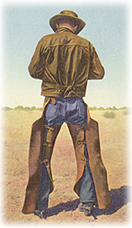 • Shotgun chaps, sometimes called "Stovepipes," were so named because the legs are straight and narrow. They were the earliest design used by Texas cowboys, in wide use by the late 1870s. The edge of each legging was usually fringed and the bottom was sometimes cut with an arch or flare that allowed a smooth fit over the arch of a boot. Shotgun chaps do not flap around the way the batwing design can (see below), and they are also better at trapping body heat, an advantage in windy, snowy or generally cold conditions. For colder weather yet, there are “woolies,” a variation of shotgun chaps. Made with a fleece, angora, or hair-on hide, and lined with canvas on the inside, they are the warmest chaps, mostly used in the northern plains and Rocky Mountains. • Shotgun chaps, sometimes called "Stovepipes," were so named because the legs are straight and narrow. They were the earliest design used by Texas cowboys, in wide use by the late 1870s. The edge of each legging was usually fringed and the bottom was sometimes cut with an arch or flare that allowed a smooth fit over the arch of a boot. Shotgun chaps do not flap around the way the batwing design can (see below), and they are also better at trapping body heat, an advantage in windy, snowy or generally cold conditions. For colder weather yet, there are “woolies,” a variation of shotgun chaps. Made with a fleece, angora, or hair-on hide, and lined with canvas on the inside, they are the warmest chaps, mostly used in the northern plains and Rocky Mountains.• Batwing chaps are cut wide with a flare at the bottom. Generally made of smooth leather, they have only two or three fasteners around the thigh, therefore allowing great freedom of movement for the lower leg. This is helpful for very active riding, also making it easier to mount the horse. This design also provides more air circulation and is therefore somewhat cooler in hot weather. Batwing chaps are often seen on rodeo riders, particularly those who ride bucking stock, and on working ranches. They were a later design, developed after the end of the open range. • Chinks (derived from "chinkaderos") are half-length chaps that stop two to four inches below the knee. They are usually fringed along the outside edge and bottom, making their length appear about four inches longer. The leg shape is cut somewhere between the batwing and shotgun type chaps, and each leg usually has only two fasteners, high on the thigh. They are cooler to wear and are occasionally called "half-chaps." Chinks are most often seen on cowboys in the Southwestern and Pacific states, most notably on those who follow the California vaquero or "buckaroo" tradition. (~Aimee) Chile Rellenos The chile relleno, which translates as "stuffed pepper," is a Mexican dish that originated in the city of Puebla. Consisting of a roasted fresh poblano pepper (the poblano pepper is named after the city of Puebla) that is stuffed with a melting cheese (such as queso Chihuahua or queso Oaxaca), it is covered in an egg batter and fried. (~Jean) 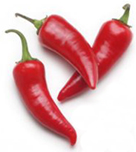 Chili Pepper Chili PepperChili is New Mexico’s largest locally grown crop. After processing, the chili crop is valued at nearly $250 million per harvest. And while the popularity of hot, spicy food has spread throughout the country, the hot, hot chili has been a staple of New Mexico cooking for centuries. Chili is one of the world’s oldest spices. Its origins can be traced to the Amazon region of South America. Although it is unclear how and when chili actually made its way to New Mexico, references to chili in the region date back to the 1500s. Some credit its arrival to Juan de Oñate, the Spaniard who first founded Espanola, and then Santa Fe in 1609; while others think chili was introduced earlier to the Pueblo Indians by the Spanish on their travels north from Mexico. Then there is the belief that chili grew wild in New Mexico many centuries before the Spanish arrived. Regardless, chili is now grown all over the state, with Hildago, Luna and Doña Ana counties topping the state’s chili production. New Mexico is the leading producer of “pungent” chili in the United States. The pungency or “heat” of chili comes from a substance called capsaicin, which is contained in the seeds of the chili. There are many types of chili and each has a differing level of heat. This is sometimes affected by the environmental factors of the area in which it is grown, such as the temperature and amount of water available. The hotness of any particular chili can be determined by the Scovile Heat Unit Scale. For example, on this scale the bell pepper is rated zero, as it has no heat, while the jalapeño pepper is rated 5,000. The average New Mexico chili is rated 5,000, comparable to the jalapeño. Red and green chilis come from the same plant. Red chili is simply riper than its green brother. In general, red is milder than green, but it is advisable when ordering in restaurants to ask your server which type is hotter. (~Jean) NOTE: See our special feature All About Chili 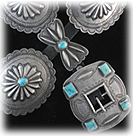 The City Different The City DifferentThe official nickname of Santa Fe, New Mexico. (~Jean) Concho (or Concha) Conchas are named for the Spanish word for shell. They are round or oval disks of silver, often tooled and decorated with turquoise or other stones. Made of heavy silver, conchas (or conchos, as they are frequently called) were often made from flattened Mexican or American silver dollars, had a decorative edge, and a slotted center through which a leather belt could be threaded. The Navajo People adopted the design of these elements, possibly from the Plains Indians or the Spanish, developing them into a unique symbol of the Navajo Nation. Popular now throughout New Mexico and the Great Southwest, they are seen on many items of clothing of the well-dressed people, both male and female, who reside in Santa Fe and Taos. (~Aimee) Conestoga Wagon 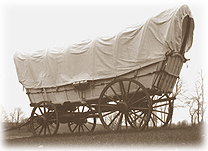 The Conestoga wagon is perhaps the best known "brand" name of wagon. It was a heavy freight-carrying wagon of a distinctive design, made in the Conestoga Valley of Pennsylvania beginning in 1725. The wagon was used to carry manufactured goods long distances to railyards. With a six-horse or oxen team, these wagons were capable of carrying loads up to eight tons. The bottom of the wagon box was curved, its lowest point in the center, to keep loads from shifting when traveling uphill or down. It does not appear that there was ever a wagon made which actually had the name Conestoga on it, and so the name Conestoga became associated with the style of the wagon construction. The "Prairie Schooner" was a modified version of the Conestoga. (~Aimee) The Conestoga wagon is perhaps the best known "brand" name of wagon. It was a heavy freight-carrying wagon of a distinctive design, made in the Conestoga Valley of Pennsylvania beginning in 1725. The wagon was used to carry manufactured goods long distances to railyards. With a six-horse or oxen team, these wagons were capable of carrying loads up to eight tons. The bottom of the wagon box was curved, its lowest point in the center, to keep loads from shifting when traveling uphill or down. It does not appear that there was ever a wagon made which actually had the name Conestoga on it, and so the name Conestoga became associated with the style of the wagon construction. The "Prairie Schooner" was a modified version of the Conestoga. (~Aimee)Cornbread Definition: “A type of bread made from cornmeal and typically leavened without yeast.” Native Americans were using ground corn for cooking long before the European explorers arrived in the New World. The Native Americans learned early to dry and grind corn into corn meal, the basic component of cornbread. When mixed with eggs and corn flour, the easiest and simplest of cornbreads can be made. Thin, dense, and flat, it was a healthy food that could be transported long distances for months at a time. Cornbread was first discovered by Europeans during their exploration of North America. Europeans who had to use the local resources for food, fashioned cornmeal into cornbread. Cornbread was popular during the Civil War, because it was very cheap and could be made in many different sizes and forms.  Cornbread is a common bread in United States cuisine, particularly associated with the South and the Southwest. It is often eaten with pinto beans or chili. Cornbread crumbs are also used in some poultry stuffings, with cornbread stuffing being closely associated with Thanksgiving Day turkeys. Some prefer a sweetened version of cornbread, while in the South and the Midwest, the sugar is left out and the cornbread is saltier. In Texas (and the Southwest), the Mexican influence has spawned a hearty cornbread made with fresh or creamed corn kernels, jalapeño peppers, and shredded cheese as a topping. Variations of cornbread include: hush puppies, corn pones, and johnnycakes. (~Jean) Cowboy Hat The Cowboy Hat has become so iconic that it can be worn virtually anywhere in the world and receive immediate recognition. Before the invention of the cowboy hat by John B. Stetson, cowpunchers of the plains states wore hats leftover from previous occupations. Top hats, derbies and Civil War caps, as well as tams and sailor caps were all worn in the early days of the Western frontier. The first cowboy hat was designed in 1865. As the story goes, John B. Stetson (and some of his companions) went West to seek the benefits of a drier climate. During a hunting trip, Stetson amused his friends by showing them how he could make cloth out of fur without weaving.  After creating his fur flannel, Stetson continued the joke by making an oversized hat with an enormous brim. But he, and his company, noticed that the hat would be useful in protecting the wearer from rain and sun. Stetson decided to wear the hat on his hunting trip. He was so happy with the outcome, that he continued wearing it on his travels throughout the West. In 1865, he began producing the first line of his oversized hats, and before long, his "joke" became known as the cowboy hat. The original Stetson hat sold for five dollars. Today, the cowboy hat is a link to the Old West, lending its wearer an air of rugged individuality and playful enjoyment that still rings of Stetson’s humorous invention. (~Aimee) After creating his fur flannel, Stetson continued the joke by making an oversized hat with an enormous brim. But he, and his company, noticed that the hat would be useful in protecting the wearer from rain and sun. Stetson decided to wear the hat on his hunting trip. He was so happy with the outcome, that he continued wearing it on his travels throughout the West. In 1865, he began producing the first line of his oversized hats, and before long, his "joke" became known as the cowboy hat. The original Stetson hat sold for five dollars. Today, the cowboy hat is a link to the Old West, lending its wearer an air of rugged individuality and playful enjoyment that still rings of Stetson’s humorous invention. (~Aimee) A Bit of Cowboy Hat Movie Trivia: In the 1960s Doris Day movie, “Pillow Talk,” Rock Hudson’s fake Texan persona is named “Rex Stetson,” although he never wears a cowboy hat in the film’s New York City setting. Hudson did, however, succeed extremely well in impersonating a Texas oilman, making the sex-farce one of the box office hits of the year. In one piece of dialogue he tells Day that being with her is "like sitting around a pot-bellied stove on a cold, winter mornin'." Now, that's a real down-home compliment, if I ever heard one! (~Jean) A Bit of Cowboy Hat Movie Trivia: In the 1960s Doris Day movie, “Pillow Talk,” Rock Hudson’s fake Texan persona is named “Rex Stetson,” although he never wears a cowboy hat in the film’s New York City setting. Hudson did, however, succeed extremely well in impersonating a Texas oilman, making the sex-farce one of the box office hits of the year. In one piece of dialogue he tells Day that being with her is "like sitting around a pot-bellied stove on a cold, winter mornin'." Now, that's a real down-home compliment, if I ever heard one! (~Jean)Coyote Fence Originally, a coyote fence was just that: sticks and pieces of broken juniper put together by Navajo and Mexican sheepherders to form a corral to protect their sheep from nightly attacks by coyotes. In modern times, old juniper fence posts and latillas are used. And today, a coyote fence may be used for many other purposes: as fencing for privacy on personal property; to hide propane tanks or storage sheds; or to simply create that special Southwestern look that has become a part of the region’s “local color.” This latilla fencing is seen everywhere throughout Taos and Santa Fe, New Mexico. (~Jean) Pictured top to bottom: 1} Cholla cactus, one of the most common in the New Mexcio high desert; 2} Carnitas in a pot; 3} New Mexico casita in winter; 4} Fried catfish goes well with cole slaw and hush puppies; 5} A cowboy wears his chaps on the range; 6} Red chili peppers; 7} Old pawn Navajo concho belt; 8} Conestoga wagon; 9} Cornbread is a favorite in Northern New Mexico; 10} Dwight Yoakam and his cool, cool Stetson hat |
|||
Home | Food | Lodging | Merchants | Services | Real Estate | Art & Galleries | Entertainment | Recreation Ski Areas | Mind-Body-Spirit | Santa Fe Information | Local Color | Canyon Road | The Turquoise Trail | Santa Fe Plaza The Pueblos | Scenic Beauty | Day Trips | Chili | Special Events | Santa Fe History | Multicultures | Museums High Road to Taos | The Wild West | Churches | Plants & Wildlife | Santa Fe Railyard | Turquoise | Architecture Fiesta | Indian Market | Spanish Market | Zozobra | Features | About Us | Get Listed! | Santa Fe Unlimited Trading Post Photo of the Week | Link of the Month | Testimonials | Santa Fe Webcams | Santa Fe Weather Santa Fe A to Z | Movie Locations | Santa Fe Unlimited Guestbook | Sitemap | Contact Us | Taos Unlimited All original graphics and content of this website, unless otherwise indicated, are copyright © 2006-2011 Santa Fe Unlimited and may not be reproduced in any fashion. |
|||

